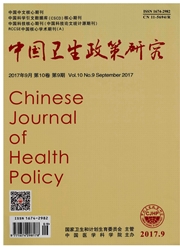

 中文摘要:
中文摘要:
目的:描述安徽省参合农民因病致贫情况,分析安徽省新农合制度抗疾病风险能力的变化,为完善新农合制度提供建议。方法:在安徽省随机抽取3个县,结合新农合制度在参合率、筹资水平和补偿比方面的变化,从因病致贫率、因病致贫解决程度、因病致贫缓解程度等方面入手,分析2013—2014年新农合制度的抗疾病风险能力。结果:2013—2014年安徽省新农合制度抗疾病风险能力有所提高,但提升有限。结论:应通过改革支付方式、控制病人外流、完善多层次保障体系等手段,逐渐减少农民因病致贫。
 英文摘要:
英文摘要:
Objective: To describe the degree of poverty caused by diseases among farmers who have joined New Rural Cooperative Medical Scheme( NRCMS) in Anhui province,and analyze the ability of NRCMS to reduce health risk factors in Anhui province,in order to provide suggestions for improving the NRCMS strategy. Methods:This paper randomly selects three counties to conduct comparative analysis on the NRCMS strategic changes from the aspects of registration rates,funding levels and compensation ratios between 2013 and 2014,in order to analyze the ability of NRCMS to reduce health risk factors from the aspects of the rate of poverty caused by diseases,the resolving degree of poverty caused by diseases,the alleviation degree of poverty caused by diseases,etc. Results: The ability of NRCMS to reduce health risk factors in Anhui province has improved between 2013 and 2014,but the improvement is limited. Conclusions: In order to reduce the incidence of poverty caused by diseases among the farmers,government should reform the payment methods,control the outflow of patients and improve the multi-level security system,in order to gradually reduce the poverty caused by diseases among farmers.
 同期刊论文项目
同期刊论文项目
 同项目期刊论文
同项目期刊论文
 期刊信息
期刊信息
